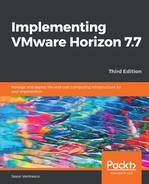This section will discuss the steps that are required to create a linked, clone-based RDS farm in Horizon.
An RDS farm is a collection of Microsoft RDS servers, and serves as the point of integration between the Connection Server and the individual applications that are installed on each RDS server. Additionally, key settings concerning client session handling and client-connection protocols are set at the RDS farm level within Horizon.
To create an RDS farm in Horizon, we need to have at least one RDS host master image configured using the steps that were described previously in this chapter. This includes taking a VM snapshot of that image once the configuration is complete; if this is not done, you will not be able to select the master image when creating the RDS farm. The following steps outline the procedure that's used to create a Microsoft RDS farm:
- Log into the Horizon Administrator console using an account that has administrative privileges.
- Navigate to Resources | Farms and click on Add..., as shown in the following screenshot:

- On the Add Farm | Type page, click the Automated Farm radio button and then click Next.
- On the Add Farm | vCenter Server page, click on the vCenter Server where the RDS master image resides and the RDS servers will be deployed, and then click Next.
- On the Add Farm | Identification and Settings page, provide a farm ID, enter a Description if desired, make any desired changes to the default settings, and then click on Next:

- On the Add Farm | Provisioning Settings page, provide a desktop Naming Pattern and the Max number of machines (RDS servers) to deploy and click on Next:

You should deploy sufficient RDS servers so that you are able to accommodate RDS server-maintenance tasks or even unplanned outages.
- On the Add Farm | Storage Optimization page, edit the settings as required, selecting the Use VMware Virtual SAN radio button if applicable, and click on Next.
- On the Add Farm | vCenter Settings page, select the RDS server Parent VM, Snapshot, VM folder location, vSphere Host or cluster, Resource pool, and Datastores, as shown in the following screenshot. Then, click on Next:

- On the Add Farm | Advanced Storage Options page, make any changes that are desired and click on Next >.
- On the Add Farm | Guest Customization page, select an AD container for the RDS server computer accounts, the Customization Specification created for the RDS servers under Using a customization specification (Sysprep), and then click on Next >.
- On the Add Farm | Ready to Complete page, review the configuration and click on Finish to create the farm.
- Once created, the farm will be listed in the Horizon Administrator console under Resources | Farms; click on it to bring up the summary page, as shown in the following screenshot:

- Click on the RDS Hosts tab to bring up a list of RDS servers that were deployed as part of the farm:

Now that the RDS servers have been deployed, we can create Horizon application pools to stream their applications to our Horizon clients. This process is described in the next section.
